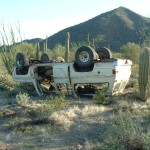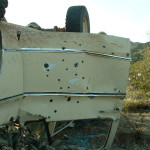An Expatriate’s View of US. Illegal Immigration
Doug Kasian,
Tucson, Arizona
http://www.desertmountaineer.com
Here in the U.S., we are undergoing a crisis caused by illegal immigration. It is a situation which needs to be decisively addressed by the U.S. federal government because of its enormous negative effects on many Americans.
I live in Tucson, Arizona. I was born in Clinton, Ontario in 1947, and lived in Canada for 35 years before moving to the U.S. for work purposes. Most Canadians and Americans have never had to go through the proper, full-blown process of gaining citizenship. They were born in their respective countries and have never had to think of how they might go about becoming citizens. Although I have maintained my Canadian citizenship, I cannot speak from experience as to what is involved in gaining Canadian citizenship now. But I can say that what I had to do to get U.S. citizenship was a lengthy and detailed process.
The company for which I worked in the U.S. had to apply on my behalf for an L-1 work visa. Many specific qualifications had to be met in order to obtain such a visa, and continuing requirements had to be strictly followed to keep it active. That work visa was a stepping-stone which a few years later allowed me to apply for Resident Alien status, more commonly known as a Green Card.. Only many years after that, eighteen to be exact, did I finally qualify and apply for U.S. citizenship. In total, all three of these steps to U.S. citizenship involved many fees and a mountain of paperwork. Therefore, I feel justified in saying that it really angers me that some people would think that they can just waltz into the U.S. illegally and get away with it. And, it adds insult to injury that these illegals have legions of supporters who agree that they should be able to do that.
As I see it, there is a major difference between immigration problems in the two countries. Although recent Canadian news stories tell of Canada Border Service raids on Canadian construction sites to catch illegal workers, Canada does not appear to suffer as much from illegal immigration, as does the U.S.
A standard estimate of the number of people who are in the U.S. illegally, and who are undocumented and without paperwork, is twelve million. But some experts feel it could be as high as twenty million. This is a staggering number, considering that it was only as recently as 1986 when amnesty was granted to three million illegal entrants. That means that, during the last 27 years, another 12 million, and possibly as many as 20 million people have swelled the ranks of the undocumented. As many critics of amnesties have argued, amnesties give potential illegals the idea that all they have to do is get into the U.S. and some day, they too will receive U.S. citizenship.
The negative economic impacts locally of illegal immigration are well-known : (1) Emergency responders – police, fire, ambulance – have an extra burden to handle, making such services less readily available to those here legally. (2) Our courts are clogged with a huge backlog of cases, many of them dealing with illegals (both individuals and members of Mexican gangs). This slows down the entire legal process for all cases. (3) Illegals apply for social services such as welfare and food stamps, stretching thin the budgets of those agencies, depriving people who are here legally of those same services. (4) Illegals clog our emergency rooms, causing long waits for everyone. Federal law says they cannot be turned away, even if they have no medical insurance; They cannot even be asked to prove they are in the country legally. (5) Hospitals have fallen on hard times by exhausting their resources to treat these illegals and are finding it is hard to get re-imbursed by the federal government. Some hospitals have had to close their doors. Finally, (6) illegals take lower-paying jobs, such as those in food services or manual labor, working under the table and for a lower wage, and making those jobs unavailable for people here legally.
I have a rather unique perspective on illegal immigration here in the U.S. I spend considerable time climbing mountains in southern Arizona, and since much of my time is in remote areas in the desert, I am witness to things most people wouldn’t believe. Within 100 miles of the Mexican border, signs of illegal immigrants are everywhere. There are countless footpaths used by these illegals as they walk from the border, heading to their pre-arranged pick-up points. There are some shocking statistics that show the effects of their passing.
Let me use the Tohono O’odham Indian Reservation, located just west of Tucson, as an example. The reservation has a 71-mile border with Mexico. Its 4,450 square-mile area (the size of the state of Connecticut) is home to only 12,000 people. Much of it is wilderness. But this sparsely-populated area acts as a magnet to attract illegal immigrants and smugglers who try to sneak into the U.S.
At its peak in 2002 – 2006, about 1,500 illegal entrants crossed the reservation border per day, or well over half a million per year. I’ll say that again : half a million illegals. I’m not talking about twenty or thirty kids having a wild party once a week on Reservation land, carelessly throwing their garbage around, and then going home. I’m talking about half a million people walking through the Reservation and the desert behind them. It’s been estimated that, speaking conservatively, they leave 5 million pounds of garbage behind every year !!! Much of this is in the form of backpacks, clothing, plastic water jugs and metal food cans. An unsightly mess, it litters the ground and gets blown around in the wind. It gets into ponds used as a water source by wildlife and cattle and into human water supplies. It falls to the tribal members to clean it up. The excrement left behind by these entrants is everywhere and spreads disease. The environmental impact of this trash and human waste is huge and has yet to be fully measured. Essentially, these illegal entrants have turned this otherwise-pristine land into an enormous garbage dump. Worse, they seem to think that somebody else should clean up their mess.
It doesn’t end there. Violence is increasing as rival Mexican gangs brazenly compete to control certain smuggling corridors on the reservation. Bullet-ridden, burned-out vehicles, usually stolen, which have been used to transport the illegals, litter the landscape, a stark reminder of turf wars. In the year 2005 alone, over 1,400 vehicles were towed off the reservation, left behind as a result of ill-fated smuggling attempts.
The economic toll of this activity is staggering – the cost of hospital care in the reservation’s only hospital , emergency evacuations, law enforcement, clean-up efforts, etc. is very large and creates a huge burden on the impoverished reservation.
There are other effects on the citizens of this Indian nation. Illegals break into their homes and businesses. They steal food, water, valuables and vehicles, sometimes at gunpoint. The Indians live in fear of being robbed, injured, raped or even killed. Some of them, made desperate from poverty, succumb to the temptation to help hide or transport illegals or drugs. The lure of easy money is too great. Sadly, many of them are caught and receive stiff prison sentences. Their world is being turned on its head.
Imagine being a community of 12,000 souls and trying to hold your own against half a million invaders each year. It’s a war zone.
The example of this Indian tribe is one story of how illegal immigration is ruining lives.
Illegal immigration is a very serious U.S. issue. Another amnesty is not the answer.






